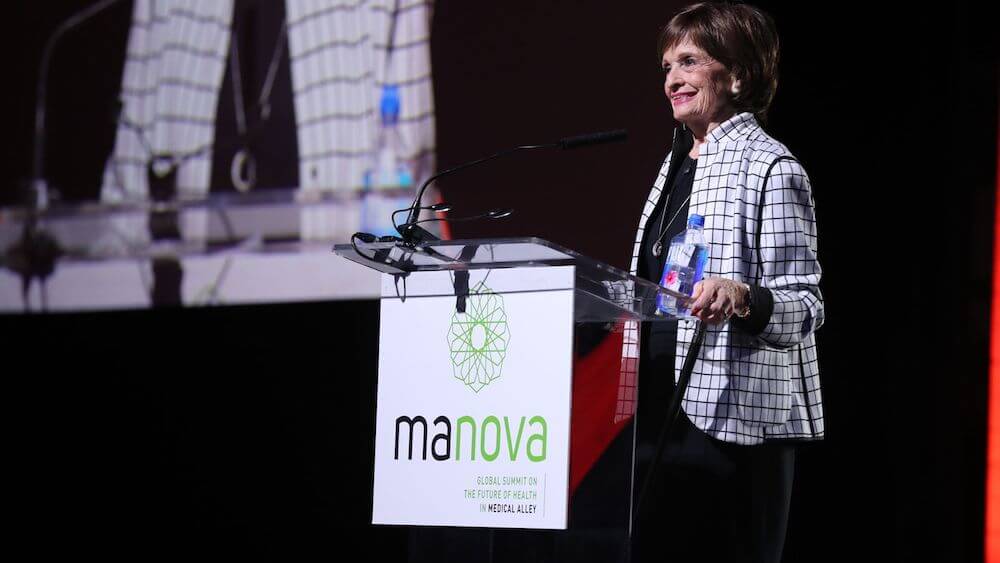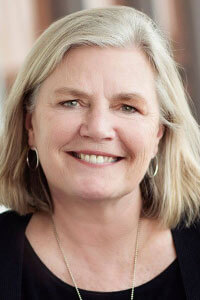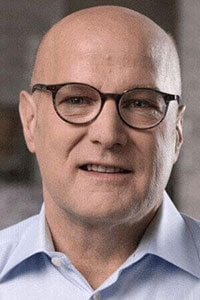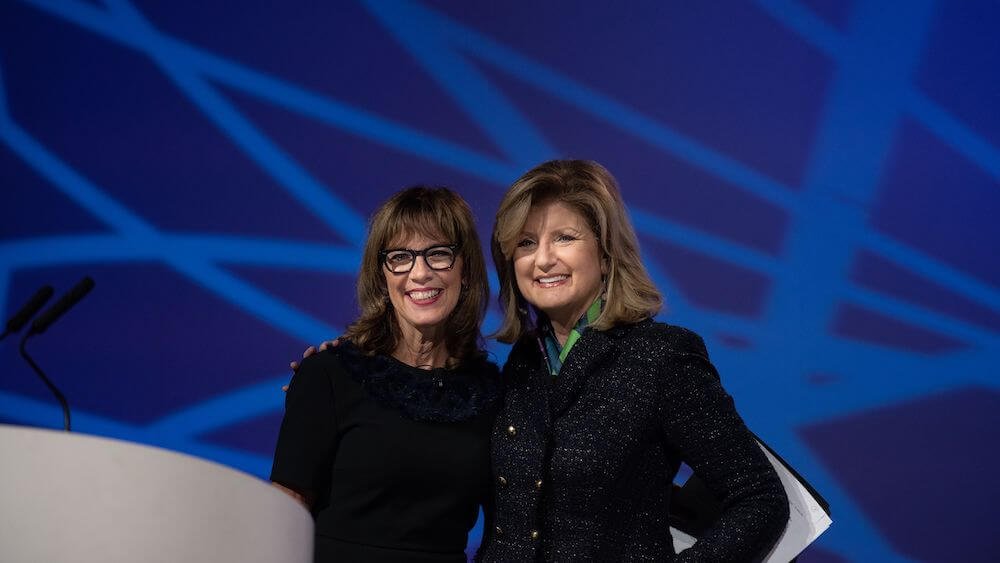
Marilyn Carlson Nelson, co-CEO, Carlson Holdings Inc., and emeritus public trustee of the Mayo Clinic, talked at last year’s Manova Summit about how to make health care more affordable, accessible, and higher quality.
When the inaugural Manova summit welcomed more than 1,000 attendees and 100-plus speakers to the Minneapolis Convention Center Oct. 8–11 last year, it was an “experiment,” Kathy Tunheim, a partner at Manova, recently told Convene. David McMillin, Convene associate editor, was among the attendees at Manova’s debut, which had started with “some scribbled notes on paper” in the summer of 2018, Manova founder and partner Mark Addicks told him last year. Five months later, it was a full-blown event.
“Everyone was interested in the idea of Manova,” Addicks told McMillin. “But we were having these very corporate conversations about waiting to do it until 2020. And I knew what would happen. We would still be waiting, and no matter when we started, we would still make freshman mistakes. So we decided to just jump in and do it, [thinking that] if it doesn’t work, we won’t do it again.”
The experiment did succeed, and they are doing it again. The second event will be held this month, Oct. 14–16, this time at the Renaissance Minneapolis Hotel, the Depot. Minneapolis as the host city remains central to the program: The name Manova is a mashup of Medical Alley and innovation — and the first event, Tunheim said, proved that the city “is a place that has the credibility and the chops” to attract “people from industry and academia and nonprofit and public policy sectors” to come together to have important conversations about the future of health care.
Convene recently followed up with both Tunheim and Addicks, who shared in a conference call what resonated in the first year with the attendees, what they’re leaning into in this year’s version, and what they’re adding to the mix.
Intersections and Adjacencies

Kathy Tunheim
Tunheim: I think what we learned in year one was this broader definition of health and all the adjacencies — including fitness, food, the environment — are things that more and more people who are working in these sectors understand. They see the intersection of those adjacencies and they want the opportunity to interact with innovators from those adjacent kind of sectors in ways that most conferences don’t create.
Most conferences are more vertical, right? People who are all in the same kinds of job. Or they’re horizontal — they’re all in the same kind of roles across companies. And what we’ve done is created a place for intersections that most of the people told us that they were meeting and hearing from people that they just haven’t had the opportunity to intersect with before. I think the primary thing we did last year to give people that sense of intersection was who was up on the stage. They were just hearing from people with backgrounds that they’d not had a chance to hear from before.
Physical Space
Tunheim: The secondary thing that we created was a very different kind of a vibe. The physical space was unique. Yes, there was a big stage in the front and there were conference tables that people could sit in rounds with colleagues that had come as teams, but a giant swath of the space was a lounge space and it created opportunities for people to sit in a cocktail-style kind of setup, visit with others, learn about new people — even as the program was going on in the front of the room. And those lounge spaces were busy all of the time. People were connecting with people in different ways even as they were engaging in the program.
Going Deeper
Tunheim: We sent out a survey to every participant last year and got a pretty phenomenal feedback in terms of the response rate. And as I recall, 85 percent of the people who responded said they would either be back or they would recommend attending to friends — so that was very positive. But then the specific things they noted were to have more time for networking and they wished they’d had a chance to do more follow-up with some of the speakers that were really provocative.
So the program in 2019 will have more of that built in. Part of the reason there was so little networking time last year is that we invited a lot of speakers, assuming that many might say no because it was a sort of an unknown new event. And because of the strength of the premise, so many of those speakers last year said yes. They were curious, and they wanted to see what this was all about. The pacing will be better this year. We’re also creating opportunities for private programming, so people can go a little bit deeper.

Mark Addicks
Addicks: We have what we call the main stage or onstage presentations. What we’re doing differently this year is every speaker will do their presentation, and then they will be escorted off — something we borrowed from the Sundance Film Festival. They will go to another room where anyone can follow them for a deeper-dive discussion or Q&A period. And that’s something every speaker will do, so that answers the questions: How do I continue the conversation? How do I get more access?
We have added networking sessions throughout. We’ve also added what we’re calling executive briefing sessions, which are private, invite-only, kind of based on your profile, where we do some deeper-dive new conversations around some of the same topics.
Also new this year, we’re starting the program with an initiative called “10 Bold Ideas,” where we have 10 different people with different titles from all over the health and wellness space get up and talk about their one bold idea for health in the future.
Choose Your Experience
Addicks: We have really curated the conversation.You should be able to go through the program and we will highlight for you what the conversations will be about in every section of every day and evening. You can say, “I’m going to see four experts on cancer therapies, treatments, disruptors. Then I’m going to world health. Then I’m going to go to mental health. Then I’m going to go to maternal health.” And we did that for this idea of deeper learning — that you’re not seeing different speakers at different times, and it doesn’t make sense.
On Monday afternoon, the first day, we’re creating the Power 30 sessions. There’ll be six stages and 30 people. It’s timed in such a way that you’ll put together your own playlist and if you want to make it more like a traditional track experience, we’ve headlined that for you.
What we think is going to happen is people are going to pick from the AI Big Data track and then become interested in a consumer speaker, then go over here for this mental health speaker. So we’re allowing people to create their own experience at Manova, to try to make this the richest experience for the attendee.
One-Day Passes
Addicks: In the true spirit of Manova being about innovation, disruption, and experimentation, we’re not just doing a three-day pass this year. We’re allowing people to buy one-day passes. If people can’t take three days off, they can still participate.
Tunheim: One of the things that we’re really committed to is making this accessible, as Mark said, and our pricing is meant to do that. The three-day pass is $599 and the one-day pass is $225. We also have discounts for students. We really want for people, if they’re interested and can make the time, to be there for at least part of the conversation.
Startup Week Co-Location
Addicks: Twin Cities Startup Week is the second-largest startup week of all the cities in America, and we are partnering with them this year. Our Manova program is offered to them through their site, and we have some specific programs that we’re doing with them as well as specific ticket offers.
We are also going to be doing a venture capital speed-dating event with Twin Cities Startup Week. This is where collectively we have some venture capital folks coming in for our conference, globally or from the coasts, and certainly local venture capitalists. It’s where startups meet a venture capital company for five minutes. No questions can be asked. They just listen and then they decide who they want to do a deeper dive with, and then we set them up for dates and rooms.
We did this at Manova last year — it was a request that came in at the last minute from several people, and we accommodated it. And to our surprise, it led to several really great deals, both for the startups as well as the companies — as well as this region, in some cases. We’re excited to do that again, and we’re formalizing that with Twin Cities Startup Week. Seventy percent of the startups, from what Twin Cities Startup Week organizers told me, are in health or technology. We intentionally put our events on the same week, and we see that as a partnership that will continue to develop.

Thrive Global CEO Arianna Huffington and Shelly Ibach, CEO of Sleep Number, spoke about the importance of sleep to good health at Manova 2018. Huffington has since named Ibach Thrive Global’s sleep editor-at-large.
Connecting Food and Health
Addicks: We are looking for more sustainable, nutritious options for our F&B at the event. One of the big speakers this year is Dr. Walter Willett who’s kind of the grandfather of public health. [Willett is a professor of epidemiology and nutrition at the Harvard School of Public Health and the lead author of “The Planetary Health Diet” report published in January.]
We’ve had confirmation that another speaker will be Dror Berman, who partners with Eric Schmidt of Google, and they have a firm that focuses a lot on the future of agriculture. I believe his topic is going to be Farm 2025, and you’ll hear about their investments where they’re using artificial intelligence and data analytics down to each plant in a remarkable way.
And then we’re going to be featuring some startups in water and food. Some people are estimating that much of our land on this globe has about 60 more harvests left before it’s depleted. So it’s immediate, and it’s urgent that we start thinking about not only how do we become more sustainable, but how do we become more regenerative.
Experiencing Minneapolis
Tunheim: Probably even more intentionally than last year, we’re making sure that the organizations in this region — the chambers and the downtown councils — who have the ability to promote the area and venues and the cool sites and institutions that are here are involved. We are also working with a number of sponsors on networking events, by invitation only, and finding really cool venues for them to go to.
CMEs
Addicks: Last year, we had several doctors come who wanted continuing medical education credits. We did not set that up last year. It is set up for this year, so we have a special outreach going to a lot of doctors. This is an inexpensive — and we think potentially more enlightening — way for them to get medical education credits.
Growing Walmart Sponsorship
Tunheim: Last year, Walmart had a pharmacy on site at Manova, and we will do that again this year. They’ll build it out a little bit more so people can get even more than the flu shot, which was offered last year.
Addicks: Over 200 million go through 11,000 Walmart stores globally every week.
Tunheim: So they have the ability to represent the priorities and the mindset of a lot of people. Another aspiration we have is things should happen at Manova that are breaking news and Walmart will be making some announcements we think are of significance at Manova this year. We expect at least one of the other companies who’s coming to speak to be making some important announcements.
More Global, Forward-Thinking
Addicks: When you look at the final lineup, you will note it’s much more global this year and we expect to have more global attendees. There are two frames we use to curate our program: Number one, the World Health Organization each year publishes its top 10 threats to global health. The No. 1 threat is climate change and the associated conditions around air pollution, water shortages, agricultural practices, etc. That’s why you see that on our program.
The second frame is a compilation of a number of white papers where we identified the top 10 opportunities — and many of these are business opportunities, but they’re not exclusively for-profit opportunities. They could be nonprofit opportunities. They’re things like artificial intelligence and data analytics, like more holistic health planning. And that speaks of course to the intersection — the prime opportunity of consumers, technology, new platforms, and new partnerships that’s really happening in health to get different health outcomes.
We used those two screens, and then we have several people this year from The Health Care 50 — Time’s list of 50 people transforming health care. We have people that were highlighted in Fast Company and Wired as well as some of the other conferences like Aspen Ideas Festival and The Wall Street Journal Health Forum.
We try to find the disruptors, people who have been out in the marketplace — either their idea or their practice looks very promising in terms of improving the health outcomes for everybody on the planet.
This interview has been edited and condensed.
More Manova
- Learn more about the Manova summit
- Read Convene’s article about the inaugural Manova summit, “Manova Global Health Care Summit Redefines the Medical Meeting.”
